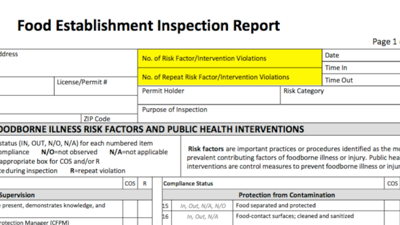WSIL — With the new year, Illinois has officially adopted the Food and Drug Administration’s most up-to-date food code.Â
Bart Hagston, Director of Environmental Health for the , says Illinois is among the proactive states in this regard. Many states are still following FDA food codes from several years ago, some dating back to 1999.Â
One of the biggest changes for restaurant managers and consumers to know is that inspectors will be using new forms. Previously forms were one page in length. Now, they are two pages or more in length, and detail both food-borne illness risk factors/public health interventions and good retail practices.Â
A more detailed report, also means a longer inspection. "The FDA wants inspectors to be in facilities longer and make workers demonstrate more of their food handling practices. It could be as simple as having them wash their hands or take temperatures of food," Hagston explains.Â
Hagston says although inspections will be more thorough, a down side is that fewer restaurants will be inspected, "I think we will be focusing more of our efforts on high and medium risk facilities and then the low risk facilities."Â
How much food a restaurant handles, determines whether the facility is a high, medium, or low risk facility. High risk facilities include sit-down restaurants, while fast food chains are a common medium risk facility. Bars and taverns that don’t serve much food are considered low risk.Â
Also, restaurants will no longer receive a score from 0 to 100. Instead, consumers will have to look for the number of violations at the top of a restaurant’s food report. The higher the number is, the greater the number of violations.Â
Hagston believes the change will portray a more accurate representation of the restaurants for consumers. However, he adds, those looking at the report will have to take more time to look at what the violations mean.Â
Due to the food inspections changes, News 3 may have to change the way we present our "Restaurant Report Card" segment in the future.














